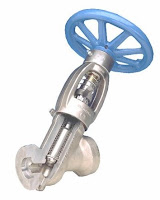 |
| Internal view of rack and pinion actuator (UniTorq) |
The rotational movement of a rack and pinion actuator is accomplished via linear motion and two gears. A circular gear, referred to a “pinion” engages the teeth of a linear gear “bar” referred to as the “rack”.
In a pneumatic actuator, pistons are attached to the rack. As air or spring power is applied the to piston, the rack is “pushed” inward or “pulled” outward. This dual direction linear movement is transferred to the rotary pinion gear providing bi-directional rotation.
 |
| Rack and Pinion Animation |
Pneumatic actuators have cylinders with pistons and springs that provide the linear movement. When one side of the piston is pressurized with air, gas or oil, the pinion bearing turns in one direction. When the air, gas or oil from the pressure side is vented, a spring (spring-return actuators) may be used to rotate the pinion gear in the opposite direction. A “double acting” actuator does not use springs, instead using the air, gas or oil supply on the opposing side of the piston to turn the pinion gear in the opposite direction.
Pneumatic pneumatic rack and pinion actuators are compact and save space. They are reliable, durable and provide a good life cycle. Mechanical wear of the heads and seals are their primary disadvantage.
Most actuators are designed for 100-degree travel with clockwise and counterclockwise travel adjustment for open and closed positions. World standard ISO mounting pad are commonly available to provide ease and flexibility in direct valve installation.
Pneumatic pneumatic rack and pinion actuators are compact and save space. They are reliable, durable and provide a good life cycle. Mechanical wear of the heads and seals are their primary disadvantage.
Most actuators are designed for 100-degree travel with clockwise and counterclockwise travel adjustment for open and closed positions. World standard ISO mounting pad are commonly available to provide ease and flexibility in direct valve installation.
 |
| Rack and Pinion Actuator (UniTorq) |
NAMUR mounting dimensions on actuator pneumatic port connections and on actuator accessory holes and drive shaft are also common design features to make adding pilot valves and accessories more convenient.
Feel free to contact Piping Specialties, Inc. at www.psi-team.com or 800-223-1468 with any questions you may have about valve actuation.
Feel free to contact Piping Specialties, Inc. at www.psi-team.com or 800-223-1468 with any questions you may have about valve actuation.


